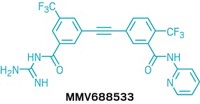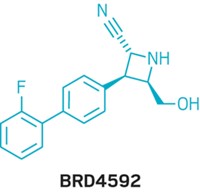Advertisement
Grab your lab coat. Let's get started
Welcome!
Welcome!
Create an account below to get 6 C&EN articles per month, receive newsletters and more - all free.
It seems this is your first time logging in online. Please enter the following information to continue.
As an ACS member you automatically get access to this site. All we need is few more details to create your reading experience.
Not you? Sign in with a different account.
Not you? Sign in with a different account.
ERROR 1
ERROR 1
ERROR 2
ERROR 2
ERROR 2
ERROR 2
ERROR 2
Password and Confirm password must match.
If you have an ACS member number, please enter it here so we can link this account to your membership. (optional)
ERROR 2
ACS values your privacy. By submitting your information, you are gaining access to C&EN and subscribing to our weekly newsletter. We use the information you provide to make your reading experience better, and we will never sell your data to third party members.
Pharmaceuticals
Giving Malaria A Double Whammy
Compound reverses resistance, acts as antimalarial agent
by Celia Henry Arnaud
April 13, 2009
| A version of this story appeared in
Volume 87, Issue 15
A NEW COMPOUND serves double duty in the fight against malaria. The dual-function molecule, based on an acridone scaffold, not only reverses resistance to quinoline antimalarial drugs such as chloroquine but also has antimalarial potency of its own (Nature, DOI: 10.1038/nature07937).
Acridones were previously shown to reverse resistance to antimalarials by sensitizing the malaria parasite to the drugs, but this is the first with intrinsic antimalarial properties. In addition to combating resistance to traditional and newer drugs, such as chloroquine and piperaquine, respectively, the new compound can kill the parasite on its own.
Dubbed T3.5, the compound consists of a tricyclic acridone scaffold with a diethylamino side chain attached to the central nitrogen. This side chain provides a hydrogen-bond acceptor needed for the sensitization. Another nitrogen-containing side chain causes the molecule to accumulate in the parasite’s acidic digestive vacuole, the drug’s presumed site of action.
T3.5’s antimalarial activity stems from its effect on heme. Heme is released when the malaria parasite, Plasmodium falciparum, digests hemoglobin from the red blood cells of its host. It is toxic to the parasite until it spontaneously aggregates into crystals known as hemozoin. T3.5 disrupts this detoxification process by binding heme through its acridone scaffold.
“The heme detoxification process is essential for the parasite’s survival,” says team member Jane X. Kelly of the Portland Veterans Affairs Medical Center, in Oregon. “This target is immutable, because it’s not encoded by the malaria parasite.” Therefore, resistance to T3.5 should be slow to develop, she says.
Kelly, team leader Michael K. Riscoe, and coworkers tested the compound alone and in combination with quinoline antimalarial drugs against several P. falciparum strains, including multidrug-resistant strains from Southeast Asia, Brazil, and Thailand. T3.5 has a synergistic effect with all the quinolines they tested except mefloquine.
“The discovery of a class of molecules with good antimalarial activity and the potential to reverse resistance to quinoline antimalarial drugs is exciting,” says Jonathan L. Vennerstrom, a medicinal chemist at the University of Nebraska who designs malaria drugs. “The authors are off to a promising start using this novel drug-design strategy.”






Join the conversation
Contact the reporter
Submit a Letter to the Editor for publication
Engage with us on Twitter